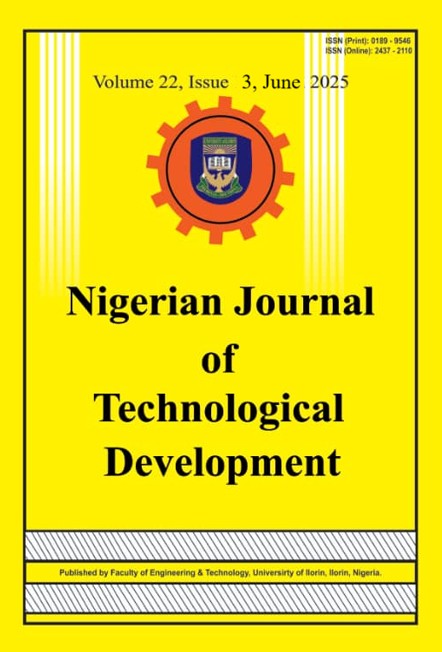Strength Evaluation and Characterization of Gmelina Arborea Timber for Structural Applications
Keywords:
BS EN 338 Strength classification, Linear regression analysis, Engineered wood product (EWP)Abstract
The increasing demand for timber in Nigeria necessitates frequent investigation into less-known timber species to ensure a steady supply for construction. This study examined the strength evaluation and characterization of Gmelina arborea timber to investigate its suitability for structural applications. Clear specimens were prepared from Gmelina Arborea timber logs taken from the base, middle, and top sections of the tree trunk. The timber was characterised based on ASTM and BS EN standards to measure moisture content (MC), density, specific gravity and various strength and stiffness properties. Results showed a mean green moisture content of 141.28% and a density of 505.03 kg/m³. The mean shear strength is 7.65 N/mm2, tensile strength and modulus of elasticity (MOE) in tension are 63.74 N/mm2 and 7741.1 N/mm2, compressive strength parallel and perpendicular to the grain are 35.83 N/mm2and 5.89 N/mm2 with MOE of 6850 N/mm2 and 450 N/mm2 respectively. The bending strength and the corresponding MOE are 58.82 N/mm2 and 11980 N/mm2. Statistical analysis revealed that Weibull distribution best fits the experimental data for density and bending strength, while the normal distribution fits the MOE in bending. Characteristic values were determined as 416.71 kg/m³ for density, 33.24 N/mm2 for bending strength, and 11980 N/mm2 for the MOE in bending. Consequently, Gmelina arborea falls into C30 strength class according to BS EN 338, confirming its suitability for structural applications.
References
ASTM (2018). Standard Test Method for Density and Specific Gravity of Wood and Wood based Materials. ASTM D2395-17. United State.
Adediji, O. C.; U. N. Wilson and I. S. Mohammed. (2023). Characterization of Three Selected Timber Specie According to BS 5268 (2002), EN 338 (2009) & NCP 2 (1973). Journal of Science and Technology Research, 5(4): 40–50.
Ataguba, C. O.; C. Enwelu; W. Aderibigbe and E. O. Okiwe. (2015). A Comparative Study of Some Mechanical Properties of Gmelina arborea, Parkia biglobosa and Prosopis africana Timbers for Structural Use. International Journal of Technological Research and Applications, 3(3): 320–324.
BS 373 (1957). Methods of Testing Small Clear Specimens of Timber. British Standard Institution, London.
BS EN 384 (2004). Structural Timber – Determination of Characteristic Values of Mechanical Properties and Density. European Standard, European Committee for Standardization.
BS EN 338 (2016). Structural Timber – Strength Classes. European Standard, European Committee for Standardization.
BS EN 408 (2010). Timber structures - Structural timber and glued laminated timber - Determination of some physical and mechanical properties. European Standard, European Committee for Standardization.
Ekundayo, O. O.; C. Arum and J. M. Owoyemi. (2022). Evaluation of Physical and Machanical Properties of Selected Wood Species Obtained from Saw Mills in Akure, Nigeria. Journal of Applied Science and Environmental Management, 26(6): 999¬-1005.
Freddy, M. and Moya, R. (2008). Moisture Content Variability in Kiln-Dried Gmelina Arborea Wood: effect of radial position and anatomical features, Journal of Wood Science, 54: 318–322, https://doi.org/10.1007/s10086-008-0954-8
Iwuaha, S. E.; W. Seim and J. C. Onyekwelu. (2021). Mechanical Properties of Gmelina Arborea for Engineering Design. Construction and building materials, 288: 1-14, https://doi.org/10.1016/j.conbuilmat.2021.123123
Karlinasari, L.; M. Wahyuna and N. Nugroho. (2008). Non-Destructive Ultrasonic Testing Method for Determining Bending Strength Properties of Gmelina Wood (Gmelina arborea), Journal of Tropical Forest Science, 20(2): 99 – 104.
Lamidi, N. A.; Q. O. Hassan; G. O. Ajoje and M. A. Muili. (2022). EN 338 Strength Characterization and Grading of Four Less-used Timber Species Grown in Nigeria for Structural Uses, LAUTECH Journal of Civil Engineering and Environmental Studies, 8(1): 29-37.
Onyekwelu, J. C.; P. Biber, and B. Stimm. (2003). Thinning scenarios for Gmelina arborea plantations in south-western Nigeria using density management diagrams, Food, Agric. Environ. 1: 320 – 325.
Oyediran, A. A.; C. M. Ikumapayi and B. Olufemi. (2023). Determination of the Properties of Some Selected Timber Specie for Structural Application. World Journal of Engineering and Technology, 11: 319 – 334.

Downloads
Published
Issue
Section
License
Copyright (c) 2025 Nigerian Journal of Technological Development

This work is licensed under a Creative Commons Attribution-NonCommercial-ShareAlike 4.0 International License.
In accordance with the Copyright Act of 1976, which became effective January 1, 1978, the following statement signed by each author must accompany the manuscript submitted: "I, the undersigned author, transfer all copyright ownership of the manuscript referenced above to the Nigerian Journal of Technological Development, in the event the work is published. I warrant that the article is original, does not infringe upon any copyright or other proprietary right of any third party, is not under consideration by another journal, and has not been published previously. I have reviewed and approved the submitted version of the manuscript and agree to its publication in the Nigerian Journal of Technological Development." A copyright transfer form can be downloaded from the NJTD Website (http://njtd.com.ng/index.php/njtd). Author(s) will be consulted, whenever possible, regarding republication of material. All authors must have access to the data presented, and the authors and sponsor (if applicable) must agree to share original data with the editor if requested.





